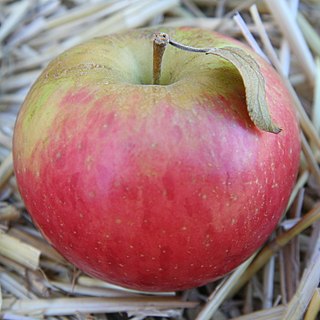In biology, the BBCH-scale for pome fruit describes the phenological development of fruits such as apples and pears using the BBCH-scale.

Phenology is the study of periodic plant and animal life cycle events and how these are influenced by seasonal and interannual variations in climate, as well as habitat factors. The word, coined by the Belgian botanist Charles Morren around 1849, is derived from the Greek φαίνω (phainō), "to show, to bring to light, make to appear" + λόγος (logos), amongst others "study, discourse, reasoning" and indicates that phenology has been principally concerned with the dates of first occurrence of biological events in their annual cycle. Examples include the date of emergence of leaves and flowers, the first flight of butterflies and the first appearance of migratory birds, the date of leaf colouring and fall in deciduous trees, the dates of egg-laying of birds and amphibia, or the timing of the developmental cycles of temperate-zone honey bee colonies. In the scientific literature on ecology, the term is used more generally to indicate the time frame for any seasonal biological phenomena, including the dates of last appearance.

An apple is a sweet, edible fruit produced by an apple tree. Apple trees are cultivated worldwide and are the most widely grown species in the genus Malus. The tree originated in Central Asia, where its wild ancestor, Malus sieversii, is still found today. Apples have been grown for thousands of years in Asia and Europe and were brought to North America by European colonists. Apples have religious and mythological significance in many cultures, including Norse, Greek and European Christian traditions.

The pear tree and shrub are a species of genus Pyrus, in the family Rosaceae, bearing the pomaceous fruit of the same name. Several species of pear are valued for their edible fruit and juices while others are cultivated as trees.
The phenological growth stages and BBCH-identification keys of pome fruit are:
| Growth stage | Code | Description |
|---|---|---|
| 0: Sprouting/Bud development | 00 | Dormancy: leaf buds and the thicker inflorescence buds closed and covered by dark brown scales |
| 01 | Beginning of leaf bud swelling: buds visibly swollen, bud scales elongated, with light coloured patches | |
| 03 | End of leaf bud swelling: bud scales light coloured with some parts densely covered by hairs | |
| 07 | Beginning of bud break: first green leaf tips just visible | |
| 09 | Green leaf tips about 5 mm above bud scales | |
| 1: Leaf development | 10 | Mouse-ear stage: Green leaf tips 10 mm above the bud scales; first leaves separating |
| 11 | First leaves unfolded (others still unfolding) | |
| 15 | More leaves unfolded, not yet at full size | |
| 19 | First leaves fully expanded | |
| 3: Shoot development1 | 31 | Beginning of shoot growth: axes of developing shoots visible |
| 32 | Shoots about 20% of final length | |
| 33 | Shoots about 30% of final length | |
| 3 . | Stages continuous till . . . | |
| 39 | Shoots about 90% of final length | |
| 5: Inflorescence emergence | 51 | Inflorescence buds swelling: bud scales elongated, with light coloured patches |
| 52 | End of bud swelling: light coloured bud scales visible with parts densely covered by hairs | |
| 53 | Bud burst: green leaf tips enclosing flowers visible | |
| 54 | Mouse-ear stage: green leaf tips 10 mm above bud scales; first leaves separating | |
| 55 | Flower buds visible (still closed) | |
| 56 | Green bud stage: single flowers separating (still closed) | |
| 57 | Pink bud stage: flower petals elongating; sepals slightly open; petals just visible | |
| 59 | Most flowers with petals forming a hollow ball | |
| 6: Flowering | 60 | First flowers open |
| 61 | Beginning of flowering: about 10% of flowers open | |
| 62 | About 20% of flowers open | |
| 63 | About 30% of flowers open | |
| 64 | About 40% of flowers open | |
| 65 | Full flowering: at least 50% of flowers open, first petals falling | |
| 67 | Flowers fading: majority of petals fallen | |
| 69 | End of flowering: all petals fallen | |
| 7: Development of fruit | 71 | Fruit size up to 10 mm; fruit fall after flowering |
| 72 | Fruit size up to 20 mm | |
| 73 | Second fruit fall | |
| 74 | Fruit diameter up to 40 mm; fruit erect (T-stage: underside of fruit and stalk forming a T) | |
| 75 | Fruit about half final size | |
| 76 | Fruit about 60% final size | |
| 77 | Fruit about 70% final size | |
| 78 | Fruit about 80% final size | |
| 79 | Fruit about 90% final size | |
| 8: Maturity of fruit and seed | 81 | Beginning of ripening: first appearance of cultivar-specific colour |
| 85 | Advanced ripening: increase in intensity of cultivar-specific colour | |
| 87 | Fruit ripe for picking | |
| 89 | Fruit ripe for consumption: fruit have typical taste and firmness | |
| 9: Senescence, beginning of dormancy | 91 | Shoot growth completed; terminal bud developed; foliage still fully green |
| 92 | Leaves begin to discolour | |
| 93 | Beginning of leaf fall | |
| 95 | 50% of leaves discoloured | |
| 97 | All leaves fallen | |
| 99 | Harvested product |
1 From terminal bud